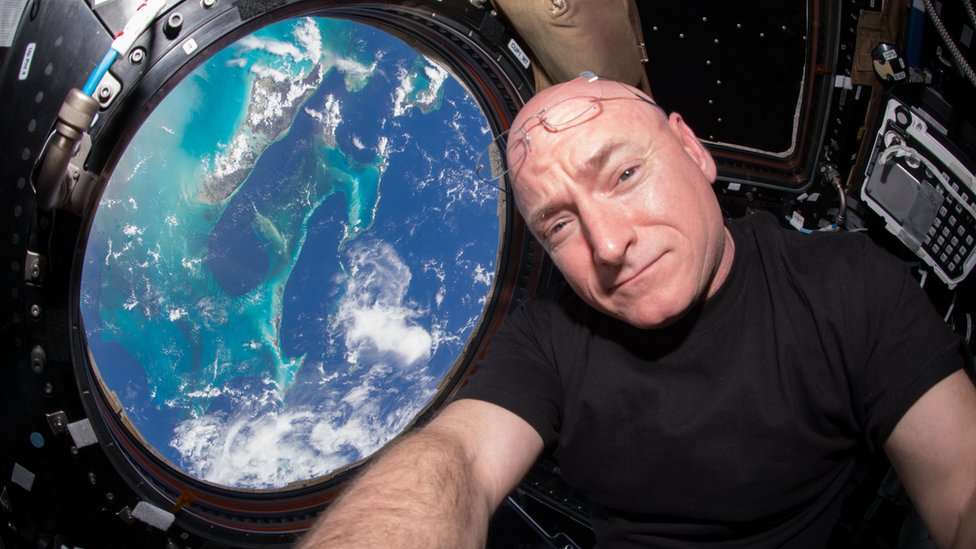
It's 16 July 2015, and all three occupants of the International Space Station are squeezing into the Russian Soyuz spacecraft that acts as their lifeboat in the event of an emergency.
The crew members have been told by mission control that a large, defunct satellite is hurtling their way at 14km per second. Controllers know it will come close, but they can't track the object precisely enough to know if it will skim by or score a devastating bullseye.
US astronaut Scott Kelly and Russians Gennady Padalka and Mikhail "Misha" Kornienko hunker down in the cramped capsule, waiting for the speeding hunk of metal to close in, following the procedures drawn up for such an eventuality by preparing to detach from the station at a moment's notice and return to Earth.
It's hardly the first time Mr Kelly, a former military pilot, has been in a life-threatening situation. But the experience caused him to ponder their collective powerlessness; had the satellite hit, there would have been no time to get away.
"Misha, Gennady and I would have gone from grumbling to one another in our cold Soyuz to being blasted in a million directions as diffused atoms, all in the space of a millisecond," he recalls in his memoir Endurance.
Crew rotations on the ISS come with many of the mundane features of everyday life on Earth: video calls, cleaning and bad days at work. But every now and then - as on this occasion - astronauts get a stark reminder of the hostile environment beyond the comforting walls of their vessel.
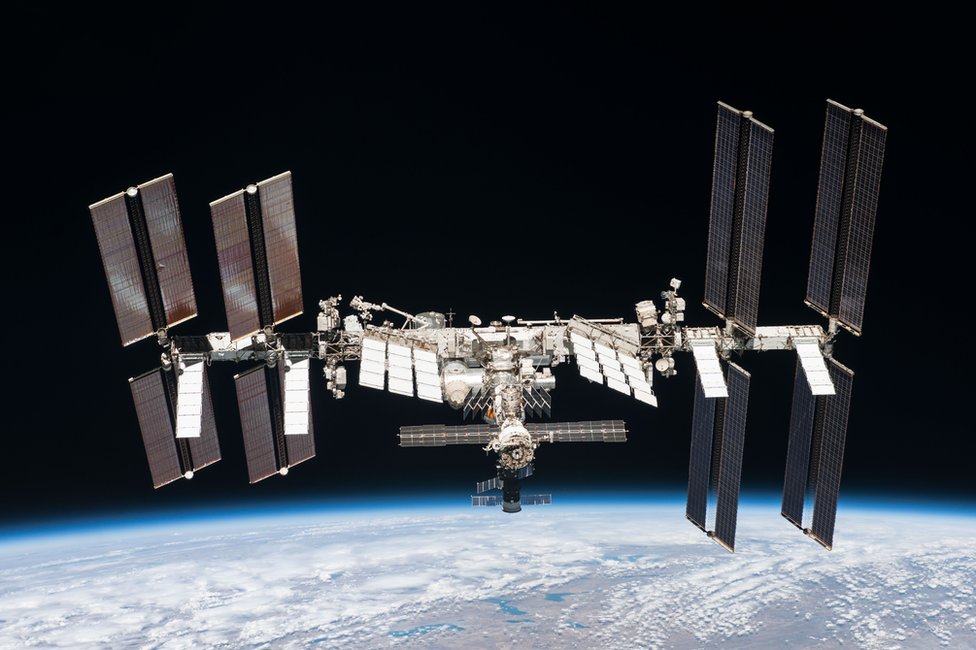
Since 2007, Kelly has made three separate visits to the orbiting outpost. But it was on his last flight between 2015 and 2016 that he gained worldwide recognition.
Along with Misha Kornienko, he was tasked with spending a whole year on the space station - twice the length of a regular stay. In doing so, he smashed the previous long duration spaceflight record for an American - set by astronaut Michael Lopez-Alegria - by more than 100 days.
But Kelly is just as well known for having an identical twin brother - Mark - who was also a Nasa astronaut. Mark, who is older by about six minutes, was elected as a senator for the state of Arizona in the 2020 US election.
Speaking to me by video call from his home in Colorado, Scott Kelly says there was never a moment he felt like coming home early. "My goal was always to get to the end of the flight with as much energy and enthusiasm as I had at the beginning - and I think I did that.
"I could have stayed up there longer, if there had been a good reason. So I never really doubted my ability to do that."
Despite the fact that astronauts and cosmonauts are screened for their psychological ability to cope, he says: "I know that other people have had hard times with it. I've seen that myself in person - some folks having a challenge being isolated like that. It's hard, but it's not so hard you can't do it."
He explains: "I don't know if it's necessarily an introvert/extravert thing, but you definitely have to be comfortable being your own entertainment," adding: "It's not for everybody."
The toughest things, he says, are not being able to go outside and experience nature, as well as the formidable daily schedule of space station tasks. Another challenge, he says, was sharing a relatively small place with the same people for so long - "even though all those people are great".
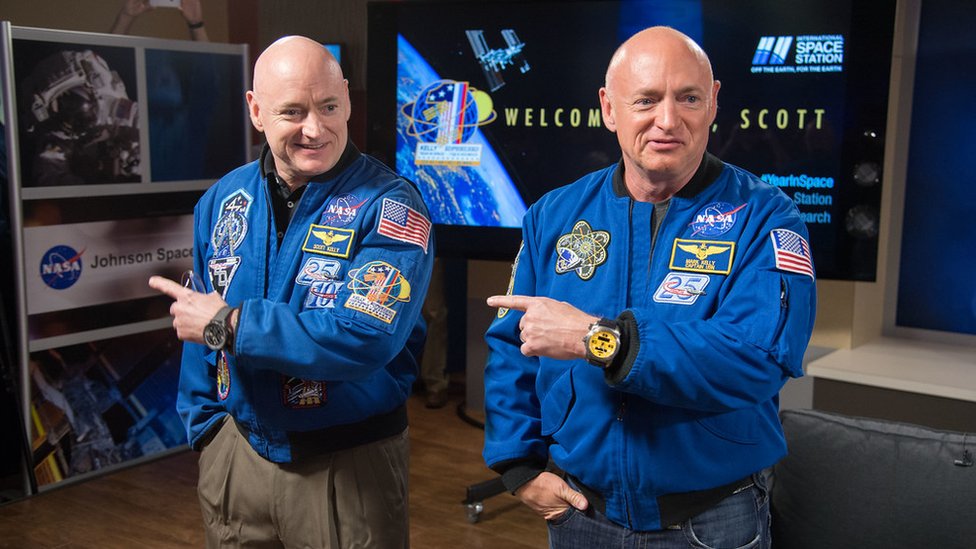
It was a challenge successfully navigated, however, as the close quarters confinement helped forge long-standing friendships: "I was just exchanging emails with (Nasa's) Kjell Lindgren. My wife and I did a video conference the other day with (Italian European Space Agency astronaut) Samantha Cristoforetti. I talk to Misha Kornienko and Gennady Padalka," he explains.
The US is committed to four more years of funding for the ISS, but uncertainties remain about support for the orbiting lab after that. The space station was born in the 1990s from a desire for co-operation in an era of political détente between the US and Russia.
"The space station programme has been a great example of international co-operation in a peaceful way," he tells me, "My experience with the cosmonauts on the station has always been one of professionalism, of respect, reliance on each other.
"My hope is that, whenever we do decide to put the space station in the Pacific Ocean, there is something there to replace it. For the last 20 years, all humans have not been on Earth at the same time. I would like to see that continue."
Kelly wasn't consumed by work for the whole of his year in orbit; he also managed to find time for much-needed fun and games. In what would become a viral video, he chased British astronaut Tim Peake through part of the space station dressed in a gorilla suit. Peake, it has to be said, does a good job of projecting alarm - if he is indeed acting.
It was Kelly's answer to Chris Hadfield's zero-g take on Space Oddity, with Kelly channelling the piano and rope-bridge sequence in Laurel and Hardy's Swiss Miss, rather than early-career Bowie.
The suit - vacuum-packed and sent up on a supply flight - was a birthday present from Mark, and I ask Scott whether it was some sort of in-joke between the brothers.
"My brother said: 'Hey, I'm sending you a gorilla suit.' And I said: 'Why are you sending me a gorilla suit?' He said: 'Why not?'" Kelly says, with a wry smile. "That's about as much thought as was put into that."
The siblings were raised in suburban New Jersey by parents who were both cops. Their mother was the first female officer in the township of West Orange where they grew up, and Scott cites the determination she showed as an inspiration in his efforts to become an astronaut.
Mark and Scott showed similar, early propensities for risk-taking that led to frequent injuries, including hospitalisations. But there was a point at school where Mark surged ahead in his studies, while Scott was prone to being easily distracted in class.
At college, it was the party scene competing for Scott's attention. He credits a phone conversation with Mark - who told him to lay off the socialising and knuckle down - with turning his academic fortunes around.
After training as a Navy pilot, Scott was assigned to a strike squadron called the World Famous Pukin' Dogs. He flew the F-14 Tomcat - the plane featured in Top Gun - during the 1990s, and carried out combat missions during the first Gulf War.
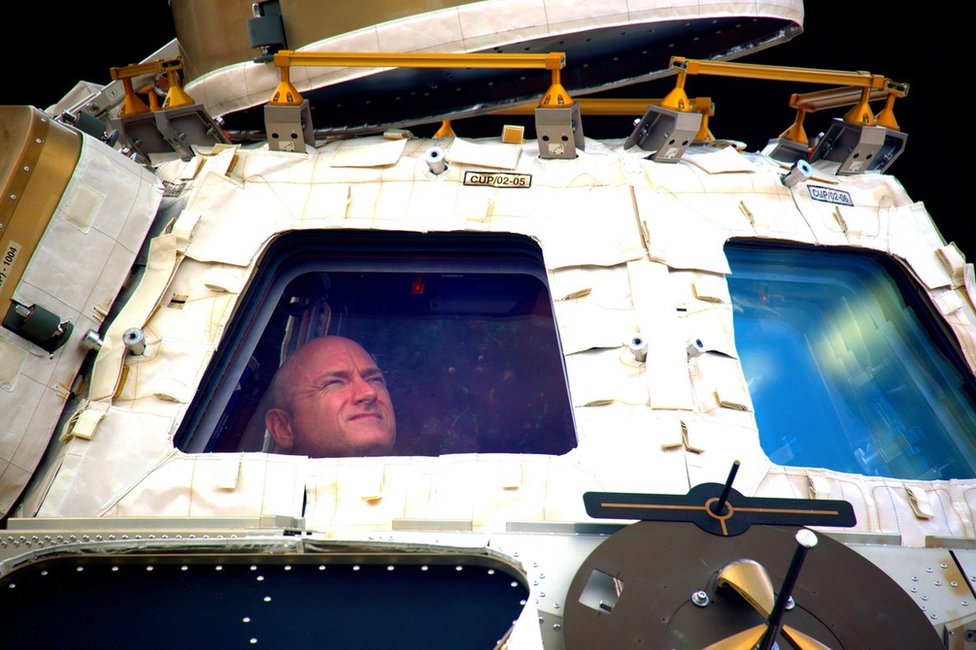
However, Kelly was eager to become part of an even more elite group - those who have flown the space shuttle. Following his selection as a Nasa astronaut in the class of 1996, along with Mark, Scott served as a pilot on one shuttle mission before commanding another in 2007.
On the shuttle, it's the commander that actually pilots the vehicle, and it's on the dizzyingly difficult landing that these skills come into their own.
"I only flew it once. It's kind of crazy to consider how much time and effort you put into doing this one piloting task and then you get to do it once, or twice," says Kelly.
"You've got one chance to land this. If you don't, it's not like you're adding power and coming around again. You recognise not only your colleagues are watching but a large part of the rest of the world."
The shuttle was a magnificent, if flawed, vehicle. And the world was reminded of the huge risks of space travel when, in 2003, the space shuttle Columbia broke up while returning to Earth - killing seven astronauts.
Nasa's safety culture was criticised by investigations in the wake of both the Challenger and Columbia disasters. Kelly lost friends on Columbia and, when I interview him, he is preparing to address the virtual
Safety Culture Summit, alongside Charles "Sully" Sullenberger - who landed a stricken US Airways flight on the Hudson River - and environmental campaigner Erin Brockovich.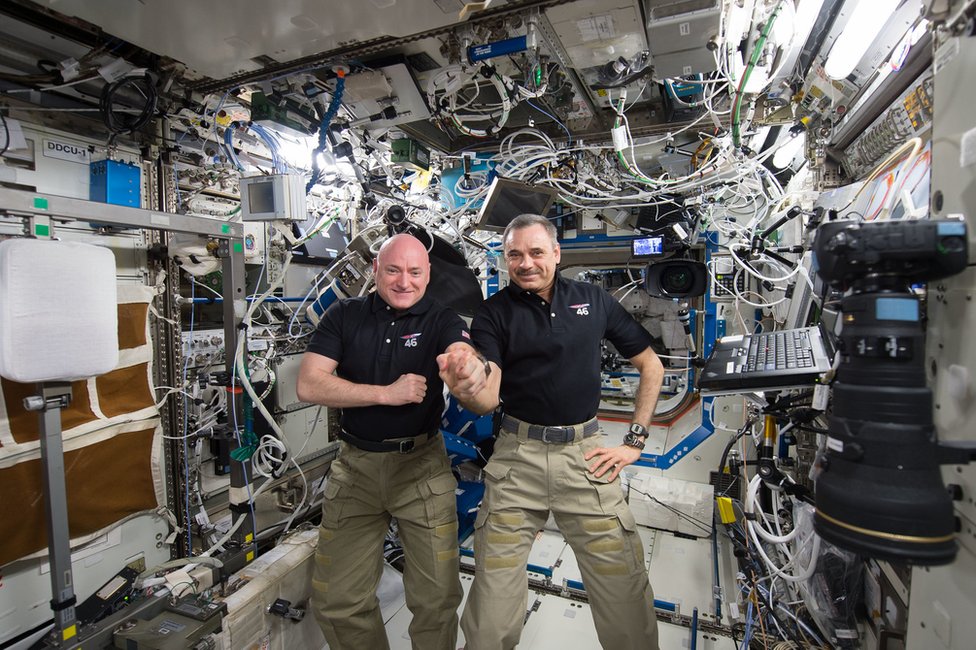
"The stuff that we do is so extraordinarily risky," he tells me. "Safety has to be everyone's responsibility… everyone needs to know that they are empowered to speak up if there's an issue."
When it was originally proposed that an identical twin would be sent into orbit for a year-long stay on the ISS, one group of scientists eyed a unique opportunity to study the effects of extended periods in space on the human body.
By using an Earth-bound Mark as a genetically identical "control", scientists would have greater confidence that any changes they were seeing in Scott were caused by the space environment. Both twins were subjected to a battery of tests measuring potential shifts in their physiology, cognitive abilities, immunity and DNA.
Among other things, the results revealed genetic changes that suggested Scott's DNA was repairing itself due to damage from cosmic radiation.
Scientists also saw unexpected changes in "caps" on the ends of Scott's chromosomes, called telomeres, as well as shifts in his blood chemistry, body mass and gut flora. But the vast majority of these reversed themselves once he was back on Earth.
Four years on, he says: "I don't have any symptoms of anything that I can definitively point to as caused by that amount of time in space, but I do have some structural and physiological changes to my eyes - though it doesn't affect my vision."
Scientists know that some people are affected more by ocular changes in space than others. And there has been work on the genetics underlying these differences. I ask Kelly if, as we learn more about how different people respond to the space environment, these biological markers could play a bigger role in astronaut selection - and whether that presents a problem.
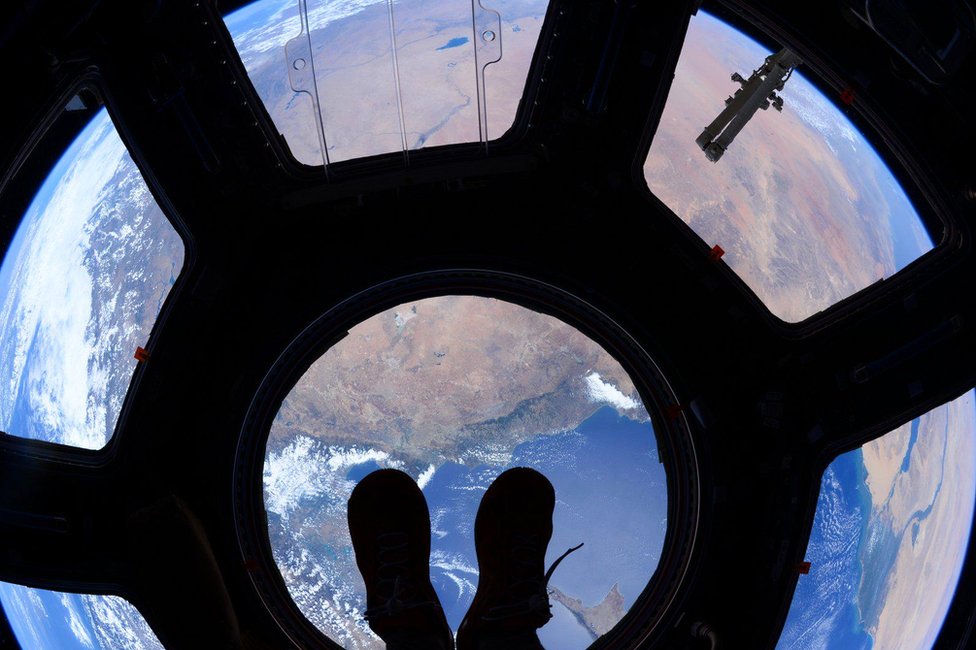
"I think that's not just an issue for Nasa but our society in general… it goes deeply into insurance and pre-existing conditions - whether genetic susceptibility could be considered a pre-existing condition. That is definitely an ethical conversation to be had," he says.
The findings of the twins study were reassuring in light of space agencies' plans to send humans on a round trip to the Red Planet, which lies 34 million miles from Earth and could take nine months each way. But astronauts will be exposed to around 10 times the radiation dose they would get in Earth orbit - putting them at long-term risk of cancers and other illnesses.
"You'll either have to find a way to shield or get to Mars quicker," Kelly says. "The other option is you just accept the risk."
It's a dilemma you suspect Kelly himself would consider carefully - even though he no longer works for Nasa. He retired in 2016, and has since been writing and speaking about his experiences. With his wife, he has since moved from Houston - the hub for Nasa's human spaceflight programme - to Colorado.
In the four years since he left, new opportunities have opened up for travel into space, and skillsets like his are in demand. The astronaut whose long duration spaceflight record Kelly overtook - Michael Lopez-Alegria - is now set to return from retirement to command a privately-funded flight to the ISS aboard Elon Musk's Crew Dragon vehicle.
Despite having achieved so much, it's clear that Kelly's fascination with spaceflight remains undiminished. "If someone asked me: 'Hey do you want to fly in space?' I'd say: 'Sure, absolutely.' Depending on what I'd be launching on: I wouldn't get into a cannon and launch myself like a cannonball," Kelly says.
"It would have to be something that made sense, that was safe. But I wouldn't rule it out.
"If you know anyone out there who has a rocket ship they need piloting…"
Follow Paul on Twitter.
https://ift.tt/2KYdldd
Science
No comments:
Post a Comment